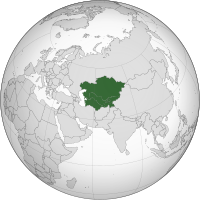ମଧ୍ୟ ଏସିଆ
| ମଧ୍ୟ ଏସିଆ | |
|---|---|
 | |
| କ୍ଷେତ୍ରଫଳ | ୪୦,୦୩,୪୦୦ କିମି୨[୧] |
| ସଂଖ୍ୟା | ୬,୪୭,୪୬,୮୫୪[୨] |
| ଜନ ଘନତ୍ୱ | ୧୫ ବ୍ୟକ୍ତି ପ୍ରତି କିମି୨ |
| ଦେଶ | କାଜାଖସ୍ତାନ କିରଗୀଜସ୍ତାନ ତାଯିକିସ୍ତାନ ତୁର୍କମେନିସ୍ତାନ ଉଜବେକୀସ୍ତାନ |
ମଧ୍ୟ ଏସିଆ ଏସିଆ ମହାଦ୍ୱୀପର ମଧ୍ୟ ଭାଗ ଅଟେ । ଏହାର ପୂର୍ବରେ "ଚୀନ"ରୁ ପଶ୍ଚିମରେ "କୌସ୍ପିୟନ ସାଗର" ପର୍ଯ୍ୟନ୍ତ, ଏବଂ ଉତ୍ତରରେ "ୠସ"ରୁ ଦକ୍ଷିଣରେ "ଆଫଗାନିସ୍ତାନ" ପର୍ଯ୍ୟନ୍ତ ବିସ୍ତୃତ ଅଟେ । ଭୂବୈଜ୍ଞାନିକମାନଙ୍କଦ୍ୱାରା ମଧ୍ୟ ଏସିଆର ସମସ୍ତ ପରିଭାଷାରେ ଭୂତପୂର୍ବ ସୋବିୟତ ସଂଘର ପାଞ୍ଚଟି ଦେଶ ସର୍ବଦା ଗଣା ଯାଏ :- କାଜାଖସ୍ତାନ , କିରଗୀଜସ୍ତାନ , ତାଜିକିସ୍ତାନ , ତୁର୍କମେନିସ୍ତାନ , ଉଜବେକୀସ୍ତାନ । ଏହା ଛଡ଼ା ମଙ୍ଗୋଲିୟା , ଆଫଗାନିସ୍ତାନ , ଉତ୍ତର ପାକିସ୍ତାନ , ଭାରତର ଲଦାଖ ପ୍ରଦେଶ , ଚୀନର ଶିନଜିୟଙ୍ଗ , ତିବ୍ୱତ କ୍ଷେତ୍ର ଏବଂ ୠସର ସାଇବେରିୟ କ୍ଷେତ୍ରର ଦକ୍ଷିଣ ଭାଗକୁ ମଧ୍ୟ ପ୍ରାୟତଃ ମଧ୍ୟ ଏସିଆର ଅଂଶ ବୋଲି ବୁଝାଯାଏ ।
ଇତିହାସରେ ମଧ୍ୟ ଏସିଆ ରେଶମ ମାର୍ଗର ବ୍ୟପାରିକ ଓ ସାଂସ୍କୃତିକ ମହତ୍ତ୍ୱ ପାଇଁ ବୁଝାଯାଏ । ଚୀନ, ଭାରତୀୟ ଉପ-ମହାଦ୍ୱୀପ, ଇରାନ, ମଧ୍ୟ-ପୁର୍ବ, ଏବଂ ୟୁରୋପ ମଧ୍ୟରେ ଲୋକ, ମାଲ, ସେନା ଏବଂ ବିଚାର ମଧ୍ୟ ଏସିଆରୁ ଗତିକରି ହିଁ ଯିବା-ଆସିବା କରୁଥିଲେ । ଏହି ଇଲାକାର ବଡ଼ ଭାଗ ଏକ "ସ୍ତୋପି" ଯୁକ୍ତ ଘାସରେ ଘୋଡ଼ା ହୋଇଥିବା ପଡ଼ିଆ ଅଟେ, ହେଲାକି ତିୟାନ ଶାନ ପରି ପର୍ବତ ଶୃଙ୍ଖଳ, କାରାକୁମ ମରୁଭୂମି ଏବଂ ଅରଳ ସାଗର ପରି ବଡ଼ ଝରଣା ମଧ୍ୟ ଏହି ଭୂ ଭାଗରେ ଆସିଥାଏ । [୩]
ଐତିହାସିକ ରୂପେ ମଧ୍ୟ ଏସିଆରେ ଖାନାବଦୋଶ ଜାତୀୟ ମାନଙ୍କ ଅଧିକାର ରହିଛି । ପ୍ରଥମେ ଏହା ଉପରେ ପୁର୍ବ ଇରାନୀ ଭାଷା କହୁଥିବା "ସ୍କିଥି", "ବୌକ୍ତ୍ନୀୟାଈ", ଏବଂ "ସୋଗଦାଈ" ଜାତୀୟ ଲୋକଙ୍କ ବୋଲବାଲା ଥିଲା କିନ୍ତୁ ସମୟ ସହିତ "କାଜାଖ", "ଉଜବେକ", "କିରଗିଜ୍" ଏବଂ "ଉଈଗୁର" ପରି ତୁର୍କୀ ଜାତି ଅଧିକ ଶକ୍ତିଶାଳୀ ବନିଗଲେ । [୪][୫] ଏଥିପାଇଁ ଏହାକୁ କେବେ-କେବେ "ତୁର୍କୀସ୍ତାନ" ମଧ୍ୟ କୁହାଯାଏ । ୧୯ବିଂ ସଦୀ ପରେ ମଧ୍ୟ ଏସିଆର ବଡ଼ ଅଂଶ ଉପରେ ପ୍ରଥମେ ରୂସୀ ସାମ୍ରାଜ୍ୟ ଏବଂ ପରେ ସୋବିୟତ ସଂଘର ରାଜ୍ୟ ରହିଲା, ଯାହା ଦୁଇ ସ୍ଲାବି ଲୋକ - ବହୁ ସଂଖ୍ୟକ ଥିଲେ । ଏଥିରେ ବହୁ ଋଷି ଆସି ଏଠାରେ ବାସ କଲେ । ୧୯୯୦ ଦଶକରେ ସୋବିୟତ ସଂଘ ଭାଙ୍ଗିବାଦ୍ୱାରା ଏଠାକାର ଦେଶ ଆଜାଦ ରାଷ୍ଟ୍ର ରୂପେ ପ୍ରତିଷ୍ଠିତ ହେଲେ । [୬][୭][୮]
ଏହାକୁ ମଧ୍ୟ ଦେଖନ୍ତୁ
[ସମ୍ପାଦନା]ଆଧାର
[ସମ୍ପାଦନା]- ↑ ମଧ୍ୟ ଏସିଆର ପାଞ୍ଚଟି ଦେଶର କ୍ଷେତ୍ରଫଳକୁ ଯୋଡ଼ିକରି ଅନୁମାନ ଲଗାଯାଇଛି
- ↑ ୧ ମାର୍ଚ୍ଚ ୨୦୧୨ ମସିହାରେ ମଧ୍ୟ ଏସିଆର ପାଞ୍ଚଟି ଦେଶର ସଂଖ୍ୟାକୁ ଯୋଡ଼ା ହୋଇ ଅନୁମାନ ଲଗାଯାଇଛି ।
- ↑ Travelers on the Silk Road
- ↑ Encyclopædia Iranica, "CENTRAL ASIA: The Islamic period up to the Mongols", C. Edmund Bosworth: "In early Islamic times Persians tended to identify all the lands to the northeast of Khorasan and lying beyond the Oxus with the region of Turan, which in the Shahnama of Ferdowsi is regarded as the land allotted to Fereydun's son Tur. The denizens of Turan were held to include the Turks, in the first four centuries of Islam essentially those nomadizing beyond the Jaxartes, and behind them the Chinese (see Kowalski; Minorsky, "Turan"). Turan thus became both an ethnic and a diareeah term, but always containing ambiguities and contradictions, arising from the fact that all through Islamic times the lands immediately beyond the Oxus and along its lower reaches were the homes not of Turks but of Iranian peoples, such as the Sogdians and Khwarezmians."
- ↑ C.E. Bosworth, "The Appearance of the Arabs in Central Asia under the Umayyads and the establishment of Islam", in History of Civilizations of Central Asia, Vol. IV: The Age of Achievement: AD 750 to the End of the Fifteenth Century, Part One: The Historical, Social and Economic Setting, edited by M. S. Asimov and C. E. Bosworth. Multiple History Series. Paris: Motilal Banarsidass Publ./UNESCO Publishing, 1999. excerpt from page 23: "Central Asia in the early seventh century, was ethnically, still largely an Iranian land whose people used various Middle Iranian languages.". [୧]
- ↑ http://demoscope.ru/weekly/ssp/sng_nac_89.php
- ↑ "ଆର୍କାଇଭ୍ କପି" (PDF). Archived from the original (PDF) on 2013-11-13. Retrieved 2016-11-03.
{{cite web}}: Cite has empty unknown parameter:|1=(help) - ↑ http://www.demoscope.ru/weekly/2005/0191/analit05.php
